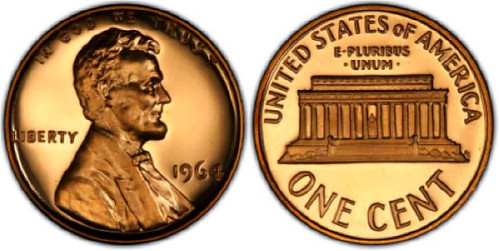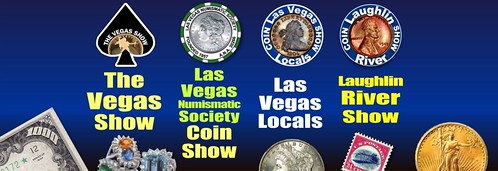
PREV ARTICLE
NEXT ARTICLE
FULL ISSUE
PREV FULL ISSUE
VOCABULARY TERMS: CAMEODick Johnson submitted these entries from his Encyclopedia of Coin and Medal Terminology. Thanks. -Editor  1964 Proof Red Cameo Lincoln Cent; Image courtesy PCGS Dick writes: Inspired by the articles in The E-Sylum the last few weeks on “Circulated Cameo” as a vocabulary term you will find here other cameo terms used in numismatics. “Circulated Cameo” will appear in the next revision in the Newman Portal. The term meets the criteria for use in the numismatic field; it accurately describes the status of such a coin, plus it is understandable by anyone. Cameo. A medallic item in raised relief similar to gem or shell cameos. Medallic cameos are almost always oval shape (usually vertical oval – see OVAL MEDAL), mostly of portraits, and often handcut. Gem cameos, cut in onyx or sardonyx, or shell cameos with layers of colors where the relief design is cut in the top layer in contrast to its background layer in a different color. Cameos – of all kinds – are always in raised relief. Cameo engraving. Historically cameo engraving thrived alongside coin engraving, as branches of the same glyptic art. Coin engravers, however, cut INTAGLIO (in iron dies to strike positive coins). Cameo engraving, on the other hand, cut positive RELIEF images in gemstones and shells by the engraver; there was no intent to reproduce the design, the engraved cameo was the end product. Cutting a cameo die by engraving is easier than cutting an intaglio die. The design – in the positive – is constantly in front of the engraver; it does not require frequent proving to inspect the state of the work. Cameo engraving requires BACKGROUND CUTAWAY, removing DEAD METAL (the unwanted metal) from the diestock leaving intact the positive image. Once completed it requires HUBBING to make a working die to strike positive pieces. The technique developed from primitive drills; early bow instruments provided power to the drill, later power was provided by a treadle, still later by water-wheel power. The drills and wheels were fed with a slurry of diamond dust and oil which aided the cutting. Today power grinders can easily remove gross metal, but it is still the hand burin that does much of the intricate detail work. Some early cameos were of scenes, often mythical or religious, but portraits predominated nearly all cameo creations. Cameo medals, like the series illustrated, exhibit typical portraits. Cameo engraving was often an apprenticeship for developing sculptural talent. The great Italian artist Benvenuito Cellini is noted for his cameos, his coins and medals, in addition to his renowned metalwork and sculpture. As a student Augustus Saint-Gaudens cut cameo gem portraits before attempting sculpture (and later, coins and medals), while medallist Victor D. Brenner cut cameo dies before learning the technique of modeling oversize medallic models and having these pantographically reduced. Cameo relief. All cameos of modern times are in relief (and only a rare ancient cameo was intaglio). Cameo relief in a sunken area – COELANGLYPTIC RELIEF – is called chevee or cuvette in French. Thus cameo cutting always had the design in positive in front of the engraver (unlike diecutting in the negative). Cameo portrait. A trend among collectors in the last decade or two of the 20th century has been the use of the term “cameo” to describe the portrait device on a proof or uncirculated coin. The Franklin Mint issued a series of such cameo medals. Cameo art illustrations. Monochrome graphic illustrations (two-dimension) of bas-relief are often called cameos. They are shaded in
such a way to indicate the rises and falls of relief. Such cameo illustrations are called camaieu. The French named the shades of gray
toning of these cameo illustrations: grisailles (there is no comparable English term). REFERENCE: Cameo Die. A handcut die of raised relief (positive), opposite of intaglio die. Hand engravers find cutting a cameo die far easier because the positive image is always in front of them (then after completion, the cameo die is HUBBED to make a striking die). Cameo diecutting requires a greater amount of BACKGROUND CUTAWAY but does not have to be constantly PROVED by the engraver (in contrast to intaglio die engraving where the hand engraver likes to make quick SPLASHERS to check newly cut detail). Typically cameo diecutting would be the device only; lettering would be added by letter PUNCHES after the positive cameo die would be hubbed into a negative working die. The term cameo die also refers to any die to strike a CAMEO, as a small medal die, usually oval shaped, and irrespective of its being hand cut or
reduced from models cut on a die-engraving pantograph. See OVAL MEDAL. Cameo Incrustation. A type of glass ornamentation molded of portraits and other devices from medals. See SULPHIDES. Cameo Medal. An oval medal in raised relief usually bearing a portrait, in similitude to a carved shell cameo. Cameo Relief. Raised relief, particularly a small relief handcut with BACKGROUND CUTAWAY. Handcut dies are often cut in cameo relief in contrast
to negative carving of INTAGLIO, because the image is constantly in positive relief before the engraver and it does not have to be proved to check
the state of the work. See RELIEF, CAMEO DIE. Looking for the meaning of a numismatic word, or the description of a term? Try the Newman Numismatic Portal's Numismatic Dictionary at: https://nnp.wustl.edu/library/dictionary Or if you would like a printed copy of the complete Encyclopedia, it is available. There are 1,854 terms, on 678 pages, in The Encyclopedia of Coin and Medal Technology. Even running two a week would require more than 19 years to publish them all. If you would like an advance draft of this vital reference work it may be obtained from the author for your check of $50 sent postpaid. Dick Johnson, 139 Thompson Drive, Torrington, CT 06790.  Wayne Homren, Editor The Numismatic Bibliomania Society is a non-profit organization promoting numismatic literature. See our web site at coinbooks.org. To submit items for publication in The E-Sylum, write to the Editor at this address: whomren@gmail.com To subscribe go to: https://my.binhost.com/lists/listinfo/esylum All Rights Reserved. NBS Home Page Contact the NBS webmaster 
|